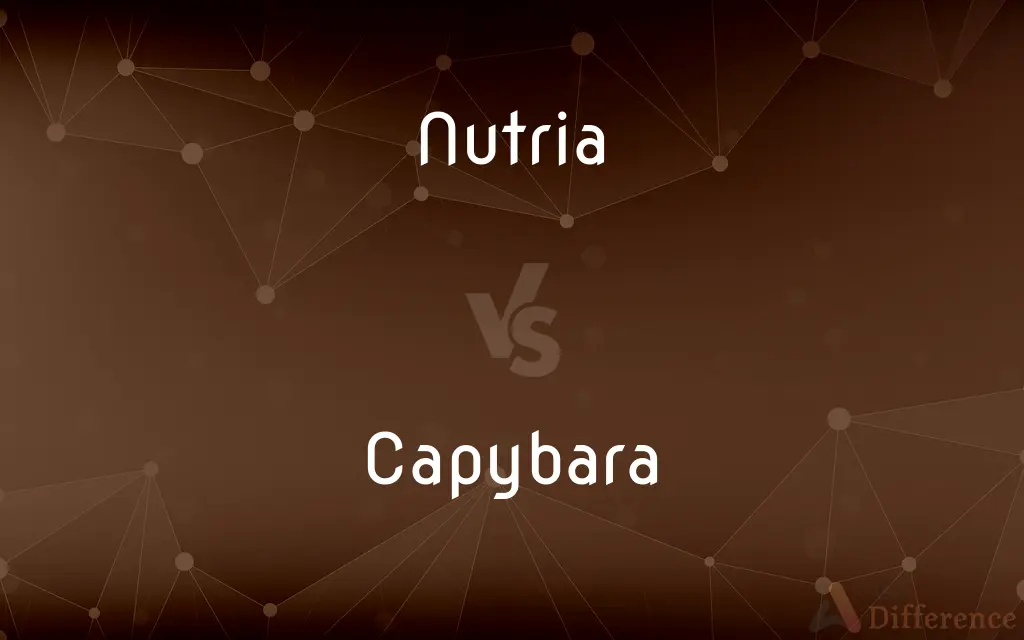Nutria vs. Capybara — What's the Difference?
By Tayyaba Rehman — Updated on September 7, 2023
Nutria are smaller, semi-aquatic rodents native to South America but invasive in other parts of the world. Capybaras are the world's largest rodents, also native to South America, and are more social animals.

Difference Between Nutria and Capybara
Table of Contents
ADVERTISEMENT
Key Differences
Nutria, also known as coypu, are semi-aquatic rodents that originated in South America but have become invasive in places like North America and Europe. Capybaras, in contrast, hold the title for being the largest rodents in the world and are native to various South American habitats including marshes, swamps, and forests.
Nutria are generally smaller than capybaras, weighing up to 20 pounds and measuring around 24 inches in length. Capybaras are significantly larger, often weighing up to 150 pounds and measuring up to 50 inches in length. Both are semi-aquatic but have different preferences when it comes to their habitats.
In terms of diet, both nutria and capybaras are primarily herbivorous. Nutria tend to eat plant stems, roots, and bark, while capybaras have a more varied diet that includes grasses, grains, and fruits. Both are known to graze near water bodies but have different impacts on their ecosystems.
Nutria are often considered pests because of their tendency to damage wetlands and compete with native species. Capybaras, on the other hand, are generally not considered invasive and are even kept as pets in some places. They have a more social nature, often seen in groups, while nutria are more solitary.
Both animals have webbed feet that make them excellent swimmers. Nutria have long, round tails and coarse fur, while capybaras have shorter, blunt tails and a sparse covering of fur. Although they share some similarities, their size, behavior, and impact on their environments make them distinct.
ADVERTISEMENT
Comparison Chart
Size
Up to 20 pounds, 24 inches
Up to 150 pounds, 50 inches
Origin
South America
South America
Invasiveness
Considered invasive in some areas
Generally not considered invasive
Social Behavior
More solitary
Social, live in groups
Diet
Plant stems, roots, and bark
Grasses, grains, and fruits
Compare with Definitions
Nutria
Nutria is a semi-aquatic rodent originally from South America.
Nutria have become invasive in parts of North America.
Capybara
Capybara is the largest rodent in the world.
The capybara can weigh up to 150 pounds.
Nutria
Nutria are herbivorous creatures that eat plant stems and roots.
Nutria are often seen grazing near ponds.
Capybara
Capybara are highly social animals.
Capybaras are often seen in groups near water.
Nutria
Nutria are often considered pests.
Nutria have been blamed for damaging wetlands.
Capybara
Capybara are native to South America.
The capybara is commonly found in South American wetlands.
Nutria
Nutria have long, round tails.
The nutria uses its long tail for balance when swimming.
Capybara
Capybara have sparse fur and webbed feet for swimming.
The capybara's sparse fur dries quickly after swimming.
Nutria
Nutria have webbed feet adapted for swimming.
The nutria's webbed feet make it an efficient swimmer.
Capybara
The capybara (Hydrochoerus hydrochaeris) is a giant cavy rodent native to South America. It is the largest living rodent.
Nutria
The skin or fur of the coypu.
Capybara
A South American mammal that resembles a giant long-legged guinea pig. It lives in groups near water and is the largest living rodent.
Nutria
A large semiaquatic rodent (Myocastor coypus) native to South America, having webbed feet and a long tail. It is widely raised for fur and has formed wild populations especially in the southern United States.
Capybara
A large semiaquatic rodent (Hydrochoerus hydrochaeris) of tropical South America, having short limbs and a vestigial tail and often attaining lengths of more than 1.2 meters (4 feet).
Nutria
The light brown fur of the nutria. In both senses also called coypu.
Capybara
A semi-aquatic South American rodent, Hydrochoerus hydrochaeris, the largest living rodent.
Nutria
The coypu, Myocastor coypus.
Capybara
A large South American rodent (Hydrochærus capybara) Living on the margins of lakes and rivers. It is the largest extant rodent, being about three feet long, and half that in height. It somewhat resembles the Guinea pig, to which it is related; - called also cabiai and water hog.
Nutria
The fur of the coypu.
Capybara
Pig-sized tailless South American amphibious rodent with partly webbed feet; largest living rodent
Nutria
The fur of the coypu. See Coypu.
Capybara
Capybara are primarily herbivorous, eating grasses and grains.
The capybara grazes near ponds and rivers.
Nutria
Aquatic South American rodent resembling a small beaver; bred for its fur
Common Curiosities
What is a Nutria?
A Nutria is a semi-aquatic rodent originally from South America.
What is a Capybara?
A Capybara is the world's largest rodent, also native to South America.
How large is a Capybara?
Capybaras can weigh up to 150 pounds and measure up to 50 inches.
How large is a Nutria?
Nutria can weigh up to 20 pounds and measure around 24 inches in length.
What do Capybaras eat?
Capybaras primarily eat grasses, grains, and fruits.
Is Nutria invasive?
Yes, Nutria are considered invasive in some areas outside South America.
Are Nutria good swimmers?
Yes, Nutria have webbed feet that make them efficient swimmers.
What do Nutria eat?
Nutria primarily eat plant stems, roots, and bark.
Is Capybara invasive?
Generally, Capybaras are not considered invasive.
Do Capybaras live in groups?
Yes, Capybaras are social animals that often live in groups.
What's the main difference between Nutria and Capybara?
The main difference is in size, social behavior, and environmental impact. Nutria are smaller and often considered pests, while Capybaras are larger and more social.
Are Capybaras good swimmers?
Yes, Capybaras also have webbed feet and are good swimmers.
Are Nutria kept as pets?
Generally, Nutria are not kept as pets and are often considered pests.
Do Nutria live in groups?
Nutria are generally more solitary animals.
Are Capybaras kept as pets?
In some places, Capybaras are kept as pets.
Share Your Discovery

Previous Comparison
Wisdom vs. Discernment
Next Comparison
Attractive vs. EngagingAuthor Spotlight
Written by
Tayyaba RehmanTayyaba Rehman is a distinguished writer, currently serving as a primary contributor to askdifference.com. As a researcher in semantics and etymology, Tayyaba's passion for the complexity of languages and their distinctions has found a perfect home on the platform. Tayyaba delves into the intricacies of language, distinguishing between commonly confused words and phrases, thereby providing clarity for readers worldwide.















































